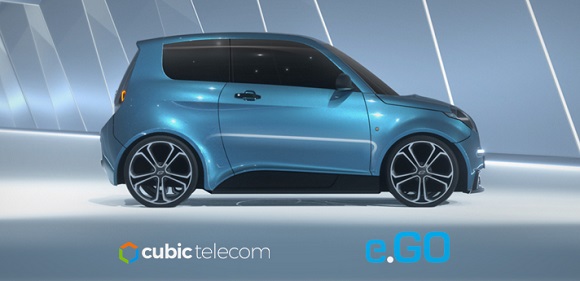Cubic on Electric Vehicles: getting the code onto the road
Nobody can fit a square peg into a round hole, obviously. We can though, perhaps paradoxically, rely on a squarely-named company to provide software-centric solutions for a round, circular, essentially wheel-based application use case.
Autonomous Wheels Technology By Cubic – might make a quirky t-shirt slogan, but the name is purely coincidental in its antonymic tautology.
Dublin-based Cubic Telecom is in fact a technology enabler for the automotive and IoT industries that is known for its Electric Vehicle (EV) connected software solutions. The company’s software enables telematics and shows drivers in real-time where to park and charge, what charging stations are available, how much battery they have left and so on.
So how does it work?
The Computer Weekly Developer Network (CWDN) spoke to Punitha Sinnapan in her role as VP for Automotive Design and Innovation at Cubic Telecom for the inside (ah-hem) track.
CWDN: Dublin is not most people’s idea of the hub for EV innovation, is Cubic an unusual company?
Punitha: Yes, and I think that is what drew me to it. It is a relatively small, dynamic company of 170 people with very diverse skill sets and talents. They approach product design in a unique way and think outside-the-box.
CWDN: Do you classify the software running in electric and autonomous vehicles as essentially ‘embedded’ software?
Punitha: I wouldn’t necessarily call it ‘embedded’ software. Embedded software generally refers to dedicated software for hardware that was built for a specific use. Autonomous Vehicle (AV) use cases require heavy compute performance; hence high-performance CPU, GPU and VPUs are being designed to meet this need. Enterprise and distributed software technologies are required. However, some systems are still embedded, but the majority are changing to adapt to new technologies.

Cubic Telecom’s Punitha Sinnapan: Knows the road… knows her code.
To achieve AV use cases, enterprise and distributed applications become integrated with security enhancements. Behind this enterprise cloud technology, you have virtualisation, container, and orchestration software. Virtualisation and containers are being used to consolidate multi-domain workloads deployed on single hardware unit. Orchestration software enhances system performance and reliability as it is used for load balancing, failover, and self-healing use cases.
Langauge for Ladas, Lancias & Lambourghinis
CWDN: What core form does the software take that you work with i.e. what language is it written in, which OS does it run… and how often are updates, upgrades, patches etc. applied?
Punitha: That will all depend on the system in the vehicle. But Python is a popular language for AI programming. C++ is another popular one out there. Golang and Rust are gaining momentum, and demand for their capabilities is significant in 2020.
There is not a single OS that fits all. Critical safety systems run on Realtime OS and AutoSAR. Infotainment systems primarily run on Linux and Android. There are multi-domain systems which run on hypervisors hosted OS environment.
The frequency Over-the-Air (OTA) software updates are applied usually depends on the OEM and will often vary from each OEM to the next. The demand for these has significantly grown in recent years, as technology advances at a rapid pace.
CWDN: Connectivity is a prerequisite to electrification. Cubic connects EVs to the cloud to make accessing this information simple for the EV owner. But connectivity is not always present (in a tunnel, behind a mountain etc.) so do you build systems with an appreciation of and provision for an inherently not-connected backbone?
Punitha: Our solutions are developed predominantly for a connected backbone. We do try to minimise ‘blind-spot’ challenges by selecting operator partners with the best coverage – those who support more network bands in each region.
Today, almost all electric vehicles have connectivity capabilities, and usually EVs are more popular in urban areas where infrastructure is mature and stable. So patchy coverage isn’t a major issue for EVs, for now.
In-car analytics
CWDN: Your company offers value-added services to EV manufacturers via real-time analytics, what functions do these actually deliver?
Punitha: We offer a descriptive analytics solution to our customers (device and vehicle manufacturers). We process raw network and vehicle data from various sources. This data is then farmed in our systems and visualized with various statistical models. We then provide the OEM with real-time monitoring and alerting notifications.
For executives, the data can inform evidence-based decision-making. For engineers and administrators, they can view and share insights and KPIs on car performance in real-time through dedicated portals. Alerts can be filtered by model, operating system, or region for proactive problem identification and resolution.
We also provide a solution called PLXOR which classifies connected services and user consumption based on network traffic. The OEM can manage and prioritise the data traffic, aligning bandwidth allocation to service propositions or customer needs.
The PACE of car-tech development
CWDN: The PACE technical solution includes real-time monitoring and remote management functions and the synchronisation of information in real-time from car to owner… what other functions are you developing next on your roadmap?
Punitha: We are looking into developing a turnkey solution comprising of connectivity, device and service management capabilities. We will be looking into on-device services to complement complex end-to-end connected car ecosystems in the near-term future.
CWDN: Some non-programmer inspiration to end with, EVs help with decarbonisation of transport targets by helping drivers go more miles with less energy, do you think we should all have a ‘gamified’ personal travel decarbonisation targets app on our smartphones to incentivise us to travel better?
Punitha: This is an excellent idea! Why not add some fun while contributing to a greater cause?
I also think that government incentives such as a tax credits on utility bills, or discounts on registration costs for lighter EVs, would positively contribute to progress in this sector. In Germany, the government subsidizes the purchase of EVs with €2K for any EV under €60K. In Europe, the Romanian government has emerged as the leader, making a €10K subsidy on each EV purchase made.
Other discount incentives I noticed from consumer businesses such as Uber and Lyft could be adapted to encourage more users to adopt EVs, for example discounts for recommending a friend, first ride is free etc. This is what ride sharing companies did to compete with taxis and it worked as it essentially benefitted the consumer!

Image: Cubic Telecom



